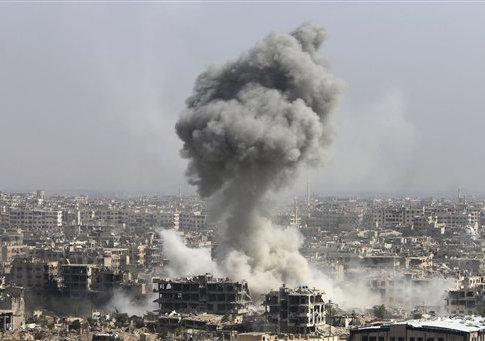Russia continues to launch airstrikes against U.S.-backed rebels in Syria despite claims by Moscow that it is primarily targeting the Islamic State terrorist group, according to reports.
U.S. officials say Russian airstrikes in Syria, which began at the end of last month, appear to be aimed at propping up Syrian President Bashar al-Assad and pushing back against rebel advances in the northwestern part of the country. The Obama administration has previously called on Assad to step down, and the CIA has trained more moderate rebel groups to apply pressure on the regime. The CIA program has also provided the rebels with TOW anti-tank missiles.
The missiles helped the rebel groups slow an offensive by pro-regime forces, but those gains are now threatened by Russia’s use of air power.
"Russia’s air campaign continues to marginalize moderate elements of the Syrian opposition by targeting moderate, U.S.-backed TOW anti-tank missile recipients," wrote Genevieve Casagrande and Jodi Brignola with the Institute for the Study of War on Wednesday. "Russian airstrikes killed the Chief of Staff of U.S.-backed TOW missile recipient First Coastal Division in the vicinity of Jebel al-Akrad on October 19."
Russia has consistently targeted the CIA-backed rebels since the start of Moscow’s air campaign, they wrote.
"Russian warplanes have targeted several other U.S.-backed TOW missile recipients since the start of the Russian aerial campaign in Syria on September 30, including Liwa Suqour al-Jebel, Liwa Fursan al-Haqq, and Tajamu' al-Izza in the provinces of Idlib and Hama, as well as the Martyr Lieutenant Ahmed Abdou Battalion in Damascus."
The Kremlin maintains that it is only attacking terrorist groups that are also U.S. enemies, including the Islamic State and the al Qaeda-linked al-Nusra Front. However, the administration has said it will not cooperate with Russia while it attempts to eliminate moderate opposition forces and preserve Assad’s rule.
"We are not prepared to cooperate in a strategy which as we explained is flawed, tragically flawed, on Russia's part," said Defense Secretary Ash Carter earlier this month.
Reuters reported on Wednesday that nearly 80 percent of Russia’s airstrikes have occurred in areas not controlled by the Islamic State, including Homs, Hama, Latakia, Idlib, and Aleppo provinces.
Terrorist groups stand to benefit from the Assad regime’s offensive in western Syria and now the major city of Aleppo, which is backed by Iranian forces, the Lebanese militant group Hezbollah, and Russian airstrikes. The Islamic State has moved to seize more territory in the north amid the onslaught against the rebels.
Additionally, Casagrande and Brignola wrote that the regime’s offensive against the rebels could spur al-Nusra to "simultaneously expand its campaign against U.S.-backed rebels with the support of allies within the Islamist opposition."
Russian airstrikes are reported to have killed more than 100 civilians in Syria, including dozens of women and children.
Assad flew to Moscow on Tuesday, ostensibly to thank Russian President Vladimir Putin for his support in the civil war. The meeting came just after Moscow and the United States reached an agreement designed to avoid incidents in Syrian airspace as the two nations conduct separate bombing missions.
Peter Cook, Pentagon press secretary, said on Tuesday that the memorandum did "not constitute U.S. cooperation or support for Russia's policy or actions in Syria."
In a statement on Wednesday, Rep. Ed Royce (R., Calif.), chairman of the House Foreign Affairs Committee, urged the administration to push back against Assad and Putin and assist civilians in Syria.
"These two strongmen are surely planning further aggression by the Syrian regime against the moderate opposition forces," he said. "Instead of sitting quietly as Assad flies to Moscow to thank his patron, the administration must act more decisively to protect innocent Syrians and push Russia to stop bombing civilian areas."
